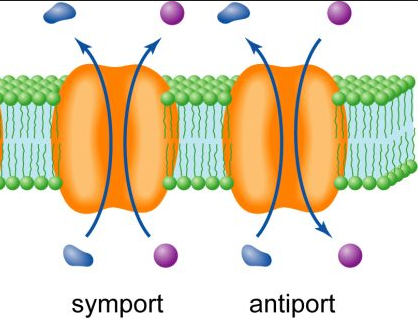Pathway of water movements in roots
There are two pathways of water passage from root hairs to xylem inside the root, apoplast and symplast.
- Apoplast pathway: In this pathway the movement of water occurs exclusively through cell wall without the involvement of any membranes. Majority of the amount of water goes through the apoplast pathway. The cortex of the root does not oppose such movement of the water.
- Symplast pathway: Here, the movement of water molecules is from cell to cell through the plasmodesmata. The plasmodesmata forms a network of cytoplasm of all cells.
Transportation of food and other substances
- Excess of food is taken into the storage organs like roots, fruits and seeds.
- This process is known as translocation and it takes place through phloem in upward as well as downward direction.
- In flowering season, sugar stored in the roots or stem is translocated to the buds for growing them into flowers.
Pressure flow hypothesis

Various theories have been put forward to explain the mechanism of phloem conduction but they are not fully satisfactory. Among them, Munch's (1930) hypothesis is most convincing.
The major steps in the mass flow theory are as follows:
The major steps in the mass flow theory are as follows:
- Active transport/active movement of sugar(sucrose) at the source into phloem cells causes the water potential of phloem contents to become more negative.
- Therefore, water flows by osmosis from adjacent cells.
- This means the hydrostatic pressure in phloem increases which causes mass flow.
- At another part of the plant (a sink e.g., the roots) the sugars are removed from the phloem by active transport so the gradients are maintain.
Factors affecting absorption of water and ascent of sap
- Water movement is regulated by root pressure and transpiration. All those factors which affect the rate of water absorption and transpiration also influence the ascent of sap.
- High temperature, atmospheric pressure, wind velocity and low atmospheric humidity influence the ascent of sap as that of transpiration.
- Soil water deficit also decrease the ascent of sap indirectly by influencing the absorption of water.
Diffusion
- Diffusion refers to the process by which molecules of matters move from high concentration towards the low concentration.
- For example, when a sugar cube is dropped in a glass of water the particles of sugar mixed up in the water as they move from higher concentration of sugar cube towards the lower concentration of water.
Exchange of gases in plants
All living organisms, including plants, get oxygen from the environment and produces energy for life process.
- Gaseous exchange in plants takes place through the stomata in the leaves, lenticels in the stem and general surface of the roots.
- The gases are exchanged by the process of diffusion.
- During daytime, the CO released by respiration is utilized for the photosynthesis. Oxygen is released during photosynthesis.
- At night, there is no photosynthesis, only respiration goes on and more CO is eliminated.
Mechanism of facilitated diffusion
- Facilitated diffusion is a form of passive transport across a biological membrane in which a transporter protein facilitates (or mediates or catalyzes) the movement of an otherwise membrane-impermeant molecule or ion across the plasma membrane down its concentration or electrochemical gradient.
- The transport proteins responsible for this function are referred to as facilitative transporters or uniporters, examples of which include the ubiquitous glucose transporters (GLUT family), a variety of amino acid transporters, facilitative urea transporters, and others.
Tonicity
Relative concentration of the solution that determine the direction and extent of diffusion is called as tonicity. The solution can be of three types based on tonicity:
- Isotonic solution with same concentration on both sides.
- Hypotonic solution in which the solution outside has a lower solute concentration causing endosmosis (inward movement of water).
- Hypertonic solution in which the solution outside has higher solute concentration causing exosmosis (outward movement of water).
Reverse osmosis
- The magnitude of the osmotic pressure is function of solute concentration in a solution. When an additional pressure is applied during the process of osmosis, then water can be made to flow out of a concentrated solution into a less concentrated one. This process is called reverse osmosis.
Plasmolysis
- Plasmolysis is the withdrawal of water from a plant cell by osmosis if placed in a strong (hypertonic) solution resulting in contraction of cytoplasm away from cell walls.
- Deplasmolysis is the reversal of plasmolysis when a plasmolysed cell is placed in water (before, the cell is dead).


Comments
Post a Comment